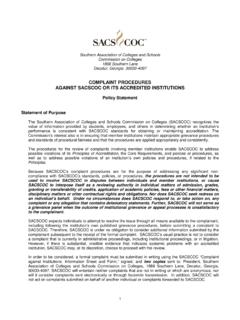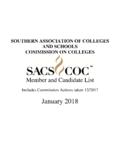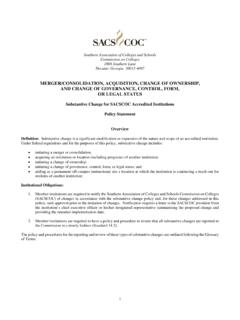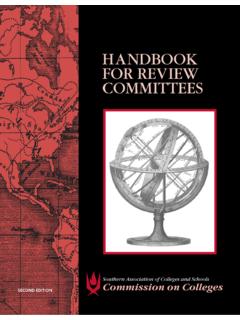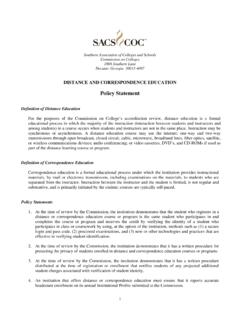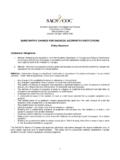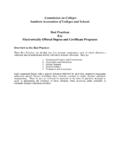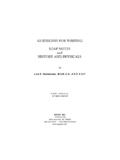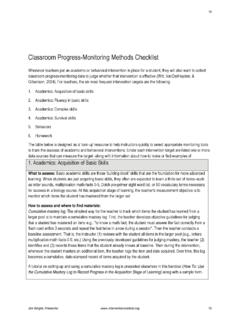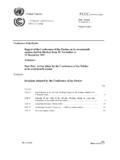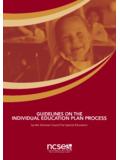Transcription of Guidelines for Writing Comments for Committee …
1 1 Guidelines for Writing Comments for Committee Reports Introduction Off-Site Reaffirmation committees and On-Site Reaffirmation committees are expected to develop Comments for each Core Requirement and Standard in the Principles of Accreditation. Comments for the standards found in compliance by the Off-Site Reaffirmation Committee are entered verbatim on the report of the Reaffirmation Committee , which is completed by the On-Site Reaffirmation Committee . Accreditation committees provide Comments for all of the Standards except Standard (Quality Enhancement Plan). Substantive Change, Special, and Candidacy committees are expected to develop Comments for each Standard identified for review by the Committee . Investing time in the development of Comments for all of the standards reviewed serves two important purposes.
2 First, the addition of Comments for those standards found in compliance provides a richer report with greater historic value. Second, the added depth provided by these Comments assists SACSCOC in demonstrating fulfillment of its responsibilities as a regional accrediting entity. In an effort to ensure that these Comments are cogent, coherent, and informative, this set of Guidelines offers four strategies for developing substantive Comments that succinctly reflect the institution s status of compliance at the time of the peer review. Strategy One Do not simply repeat the standard. Why not? Because a simple repetition of the standard provides no specific details relative to the institution under review. This lack of detail significantly reduces the report s historic value. Example One: CR The institution engages in ongoing, comprehensive, and integrated research-based planning and evaluation processes that (a) focus on institutional quality and effectiveness and (b) incorporate a systematic review of institutional goals and outcomes consistent with its mission.
3 (Institutional planning) Compliance Comment: The institution engages in ongoing, comprehensive, and integrated research-based planning and evaluation processes that (a) focus on institutional quality and effectiveness and (b) incorporate a systematic review of institutional goals and outcomes consistent with its mission. 2 Notice how this comment lacks any reference to the institution reviewed. A comment should contain some specific details that not only tie it to the institution under review but also make that particular comment inappropriate for other institutions. In other words, Comments need to be customized. This comment, however, could be applied to virtually any member institution. Strategy Two Include details specific to the institution. Why? Because specific details not only confirm that the reviewer has digested the narrative and documentation presented in the Compliance Certification, but such Comments also provide a thumbnail sketch of the institution s compliance at the time of the review.
4 Example Two: CR The institution engages in ongoing, comprehensive, and integrated research-based planning and evaluation processes that (a) focus on institutional quality and effectiveness and (b) incorporate a systematic review of institutional goals and outcomes consistent with its mission. (Institutional planning) Notice how details such as the Advisory Committee on the Planning Process, the dates of the current strategic plan, and 2-3 day planning and assessment retreats held each spring or summer tie this comment to a particular institution. That the language of this comment would apply verbatim to any other member institution is unlikely. Strategy Three Reference the documentation reviewed. Why? Because references to the documentation that has been examined tie the comment even more tightly to the specific institution under review and establish an important historical note should further review of the same issue become necessary in the future.
5 Example Three: CR The institution engages in ongoing, comprehensive, and integrated Compliance Comment: The institution uses a multifaceted approach to planning and evaluation that includes a systematic strategic planning process, an annual planning and evaluation process, and a program review process. The institution s Advisory Committee on the Planning Process and its Planning Committee coordinated the development of the institution s current strategic plan (2015-2019) ensuring that all campus constituencies were involved. The institution s annual evaluation and planning process involves 2-3 day planning and assessment retreats held each spring or summer for the purposes of reviewing progress on current goals and for developing goals, expected outcomes, and methods for achieving outcomes for the upcoming year.
6 A review of the results from these retreats revealed evidence that the institution uses the evaluation and assessment results to improve its programs and services. Changes resulting from assessment are clearly linked to the institution s mission as indicated in the minutes of the Planning Committee . 3 research-based planning and evaluation processes that (a) focus on institutional quality and effectiveness and (b) incorporate a systematic review of institutional goals and outcomes consistent with its mission. (Institutional planning) Note how easily a reference to key documentation was slipped into the first sentence. Strategy Four Address all parts of the standard. Why? Because SACSCOC needs to document a comprehensive review. The historic value of a report is severely compromised when the comment does not clearly indicate compliance with all aspects of the standard.
7 Example Four: Standard The institution publishes and implements appropriate policies and procedures for preserving and protecting academic freedom. (Academic freedom) Non-Compliance Comment: The Committee s review of section of the F aculty Handbook indicates that the institution has a policy on academic freedom which is appropriately published. This policy contains procedures regarding alleged violations of academic freedom, including a procedure through which a faculty member may defend himself or herself against such allegations. These procedures appear to outline an appropriate process, with clear timelines and steps. The Committee was unable to determine, however, whether the institution has implemented its policy and procedures regarding academic freedom. Compliance Comment: The Committee s review of the last five annual Planning Initiatives and Assessment Results reports confirms that the institution engages in ongoing and systematic planning and evaluation that leads to improvement of its programs and services and the fulfillment of its mission.
8 The college uses a multifaceted approach to planning and evaluation that includes a systematic strategic planning process, an annual planning and evaluation process, and a program review process. The institution s Advisory Committee on the Planning Process and the Planning Committee coordinated the development of the institution s current strategic plan 2010-2014) ensuring that all campus constituencies were involved. The institution s annual evaluation and planning process involves 2-3 day planning and assessment retreats held each spring or summer for the purposes of reviewing progress on current goals and for developing goals, expected outcomes, and methods for achieving outcomes for the upcoming year. A review of the results from these retreats revealed evidence that the institution uses the evaluation and assessment results to improve its programs and services.
9 Changes resulting from assessment are clearly linked to the institution s mission as indicated in the minutes of the Planning Committee . 4 The dual requirements embedded in this Standard are not enumerated, yet the comment needs to establish (1) whether the institution has published appropriate policies and procedures related to preserving and protecting academic freedom and (2) whether the institution has demonstrated implementation of its policy and procedures. Some standards flag multiple requirements more clearly. Consider, for example, Standard : If an institution s governing board does not retain sole legal authority and operating control in a multiple-level governance system, then the institution clearly defines that authority and control for the following areas within its governance structure: (a) the institution s mission, (b) fiscal stability of the institution, and (c) institutional policy.
10 (Multi-level governance) Length How long should these Comments be? Just long enough to make a clear, unambiguous statement of the institution s degree of compliance with all parts of the standard and to provide details specific to the institution and the documentation reviewed. Some standards, such as Core Requirements , , and , may generate Comments as short as a single sentence. Other standards, as illustrated above, require greater length. Instances of non-compliance may demand the greatest length because the text needs to establish the foundation for a recommendation or for an Off-Site Reaffirmation Committee referral to the On-Site Reaffirmation Committee . Edited: August 2018

